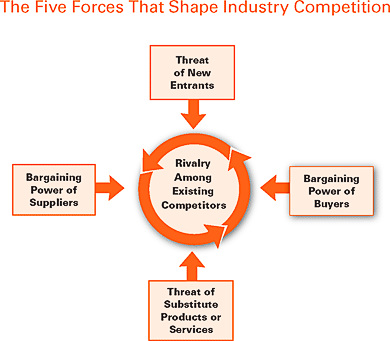Business environment is dynamic and affected by market forces; in 1985, Michael Porter, developed a five stage mechanism that could be used to evaluate the industrial position of a company. The forces operate regardless of the industry or the country of operation (Michael, 1997).
Technological development has resulted to a number of businesses, one of them being the film industry. A number of players have entered in the industry to tap the growing markets. This paper undertakes an industrial analysis of the movie industry; it will adopt porter’s five forces of industrial analysis.
Supplier’s power
The industry has many suppliers some who have strong brand/stage name while others are upcoming artists. The kind of movie that a certain company chooses determines the suppliers to have, thus suppliers influences on the market share that a company is likely to enjoy.
The industry is dynamic and the products demanded by the consumers at one point differ greatly; for successful rental business, managers of such entities need to know their target market and the kind of tastes they have at a particular time, and then aim at providing such movies. The high number of suppliers favours the industry (Michael, 1997).
Buyer’s power
The movie rental industry is one of the industries that is affected by the tastes that buyers have; the buyers taste need to be respected, it shapes the stock genre, to be stocked by a certain company. With the growing technology, there are new products in the market, thus for a successful business then a company need to be updated with current market trends. The unpredictable buyer’s tastes are unfavourable in the industry.
Barriers to entry
Companies in an industry place certain barriers to entry in the market. These barriers include economies of scales, low production cost and input access strategy. In the movie rental industry, there are minimal barriers to entry, the industry require relatively low capital and have a wide range of clients that a company can tap.
One of the most outstanding barriers to entry is the understanding of the market companies in the industry need to understand consumer trend and treat them as so. Low entry barriers favours new entrants to the disadvantage of old players (Hooley & Saunders, 1993).
Threats of substitutes
The industry is highly competitive with different genres that a customer can choose from; other than the genre, there are other ways of accessing a movie like going to theatre and cinema halls instead of renting. In modern movie industry, producers are developing a movie and a book to relate to the movie thus a customer has a choice of either. The existence of substitutes is not favourable to the industry (Paley,1999).
Rivalry
National and international movie rental business is highly competitive. To maintain competitive in such an industry, companies require offering consumer oriented services. It should be offer reliable services and aims at developing customer royalty towards its products. Rivalry is not favourable to the industry (Peter, 2006).
The image below shows how the five forces affect the industry:

(Michael, 1997).
Critical success factors for Redbox, Netflix, and Movies on Demand.
To remain competitive in the movie industry, a company need to adopt the following critical success factors:
- Strike a balance between the different tastes that customers have
- Being up-to-date with new movies in the market
- Fulfilment of customer needs through a continual improvement of customer values
- Capture content and provide context
- Adopt high customer service standards and create building blocks to sustain a strong customer base.
References
Hooley, G., & Saunders J.(1993). Competitive Strategy: the Key to Marketing Strategy. New York: Prentice Hall,
Michael, P.(1997). Competitive Advantage: Creating and Sustaining Superior Performance. Beijing: Hua Xia Press.
Paley, N.(1999). The manager’s guide to competitive marketing strategies. London: CRC Press.
Peter, D. (2006). Marketing Management and Strategy. London: Post & Telecom Press